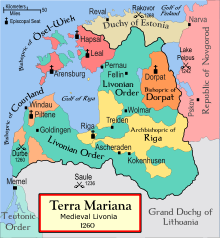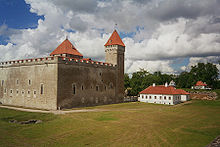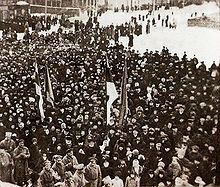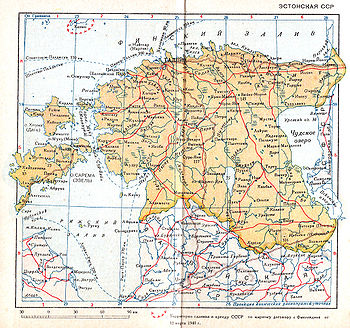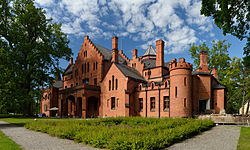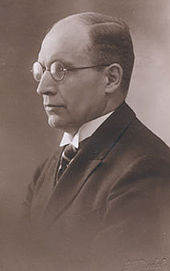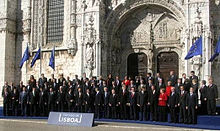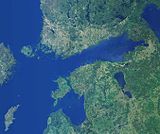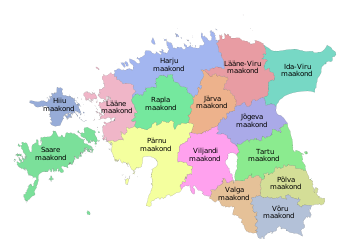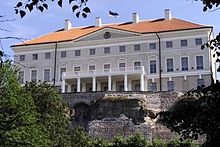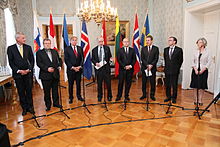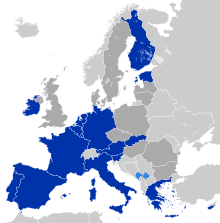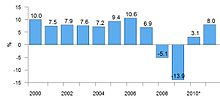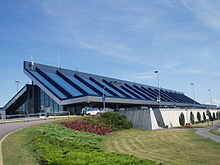
Estonia
About this schools Wikipedia selection
SOS Children volunteers helped choose articles and made other curriculum material SOS Children works in 45 African countries; can you help a child in Africa?
| Republic of Estonia Eesti Vabariik
|
||||||
|---|---|---|---|---|---|---|
|
||||||
Anthem:
|
||||||
|
Location of Estonia (dark green)
– in Europe (green & dark grey) |
||||||
| Capital and largest city |
Tallinn 59°25′N 24°45′E |
|||||
| Official languages | Estoniana | |||||
| Recognised regional languages |
|
|||||
| Ethnic groups (2011 ) |
|
|||||
| Demonym | Estonian | |||||
| Government | Parliamentary republic | |||||
| - | President | Toomas Hendrik Ilvesc | ||||
| - | Prime Minister | Andrus Ansip ( RE) | ||||
| - | Parliament speaker | Ene Ergma ( IRL) | ||||
| - | Current coalition | RE / IRL | ||||
| Legislature | Riigikogu | |||||
| Independence | ||||||
| - | Autonomy declared | 12 April 1917 | ||||
| - | Independence declared then recognised |
24 February 1918 2 February 1920 |
||||
| - | Annexed by the Soviet Union | 1940–1941 | ||||
| - | Nazi German occupation | 1941–1944 | ||||
| - | Restored to the Soviet Union | 1944–1991 | ||||
| - | Independence restored | 20 August 1991 | ||||
| Area | ||||||
| - | Total | 45,227 km2 ( 132ndd) 17,413 sq mi |
||||
| - | Water (%) | 4.45% | ||||
| Population | ||||||
| - | 2013 estimate | 1,286,540 ( 151st) | ||||
| - | 2011 census | 1,294,455 | ||||
| - | Density | 29/km2 ( 181st) 75/sq mi |
||||
| GDP ( PPP) | 2012 estimate | |||||
| - | Total | $27.313 billion | ||||
| - | Per capita | $21,059 | ||||
| GDP (nominal) | 2012 estimate | |||||
| - | Total | $22.225 billion | ||||
| - | Per capita | $16,636 | ||||
| Gini (2009) | 31.4 medium |
|||||
| HDI (2013) | very high · 33rd |
|||||
| Currency | Euro ( €)e ( EUR) |
|||||
| Time zone | EET ( UTC+2) | |||||
| - | Summer ( DST) | EEST ( UTC+3) | ||||
| Drives on the | right | |||||
| Calling code | +372 | |||||
| ISO 3166 code | EE | |||||
| Internet TLD | .eef | |||||
| a. | According to the Constitution, Estonian is the sole official language. In southern counties, Võro and Seto are spoken along with it. Russian is still unofficially spoken in Ida-Virumaa and Tallinn, due to the Soviet Union's program promoting mass immigration of urban industrial workers during the post-war period. | |||||
| b. | Including 5.4% Võros and 0.93% Setos. | |||||
| c. | SDE member but nonpartisan while in office. | |||||
| d. | 47,549 km2 (18,359 sq mi) were defined according to the Treaty of Tartu in 1920 between Estonia and Russia. Today, the remaining 2,323 km2 (897 sq mi) are still occupied and part of Russia. The ceded areas include most of the former Petseri County and areas behind the Narva river including Ivangorod (Jaanilinn). Pechory remains under Russian control. | |||||
| e. | Estonian kroon (EEK) before 2011. | |||||
| f. | Also .eu, shared with other member states of the European Union. | |||||
Estonia / ɨ s ˈ t oʊ n i ə / ( Estonian: Eesti), officially the Republic of Estonia ( Estonian: Eesti Vabariik), is a state in the Baltic region of Northern Europe. It is bordered to the north by the Gulf of Finland, to the west by the Baltic Sea, to the south by Latvia (343 km), and to the east by Lake Peipus and Russia (338.6 km). Across the Baltic Sea lies Sweden in the west and Finland in the north. The territory of Estonia covers 45,227 km2 (17,462 sq mi), and is influenced by a temperate seasonal climate. The Estonians are a Finnic people, and the official language, Estonian, is a Finno-Ugric language closely related to Finnish and distantly to Hungarian.
Estonia is a democratic parliamentary republic divided into 15 counties. The capital and largest city is Tallinn. With a population of 1.29 million, it is one of the least-populous members of the European Union, Eurozone and the North Atlantic Treaty Organization. Estonia has the highest gross domestic product per person among the former Soviet republics. It is listed as a "high-income economy" by the World Bank, is identified as an "advanced economy" by the International Monetary Fund, and is a member of the Organisation for Economic Co-operation and Development. The United Nations classifies Estonia as a developed country with a very high Human Development Index, and the country ranks highly in measures of press freedom (3rd in the World in 2012), economic freedom, political freedom and education, and is one of the lowest in religiosity. Estonia is often described as one of the most wired countries in Europe.
Etymology
One hypothesis is that the modern name of Estonia originated from the Aesti described by the Roman historian Tacitus in his Germania (ca. 98 AD).
Ancient Scandinavian sagas refer to a land called Eistland, as the country is still called in Icelandic, and close to the Danish, German, Dutch, Swedish and Norwegian term Estland for the country. Early Latin and other ancient versions of the name are Estia and Hestia.
Esthonia was a common alternate English spelling prior to independence.
History
Prehistory
Human settlement in Estonia became possible 11,000 to 13,000 years ago, when the ice from the last glacial era melted. The oldest known settlement in Estonia is the Pulli settlement, which was on the banks of the river Pärnu, near the town of Sindi, in south-western Estonia. According to radiocarbon dating it was settled around 11,000 years ago at the beginning of the 9th millennium BC.
Evidence has been found of hunting and fishing communities existing around 6500 BC near the town of Kunda in northern Estonia. Bone and stone artefacts similar to those found at Kunda have been discovered elsewhere in Estonia, as well as in Latvia, northern Lithuania and in southern Finland. The Kunda culture belongs to the middle stone age, or Mesolithic period.
The end of the Bronze Age and the early Iron Age were marked by great cultural changes. The most significant was the transition to farming, which has remained at the core of the economy and culture. Between the 1st to 5th centuries AD resident farming was widely established, the population grew, and settlement expanded. Cultural influences from the Roman Empire reached Estonia.
The first mention of the people inhabiting present-day Estonia is by the Roman historian Tacitus, who in his book Germania (ca. AD 98) describes the Aesti tribe. Tacitus mentions their term for amber in an apparently Latinised form, glesum (cf. Latvian glīsas). This is the only word of their language recorded from antiquity. In spite of this point, the Aestii are generally considered the ancestors of the later Baltic peoples.

A more troubled and war-ridden middle Iron Age followed with external dangers coming both from the Baltic tribes, who attacked across the southern land border, and from overseas. Several Scandinavian sagas refer to retaliatory campaigns against Estonia. Estonian pirates conducted similar raids against the Vikings. The "pagan raiders" who sacked the Swedish town of Sigtuna during the early Middle Ages, in 1187, were Estonians.
In the 1st centuries AD, political and administrative subdivisions began to emerge in Estonia. Two larger subdivisions appeared: the province (Estonian: kihelkond) and the land (Estonian: maakond). The province comprised several elderships or villages. Nearly all provinces had at least one fortress. The defense of the local area was directed by the highest official, the king or elder. By the 13th century the following major lands had developed in Estonia: Revala, Harjumaa, Saaremaa, Hiiumaa, Läänemaa, Alempois, Sakala, Ugandi, Jogentagana, Soopoolitse, Vaiga, Mõhu, Nurmekund, Järvamaa and Virumaa.
Estonia retained a pagan religion centred around a deity called Tharapita. The Chronicle of Henry of Livonia mentions Tharapita as the superior god of Oeselians (inhabitants of Saaremaa island), also well known to Vironian tribes in northern Estonia.
Viking Age
The Oeselians or Osilians ( Estonian saarlased; singular: saarlane) were a historical subdivision of Estonians inhabiting Saaremaa ( Danish: Øsel; German: Ösel; Swedish: Ösel), an Estonian island in the Baltic Sea. They are first thought to be mentioned as early as the 2nd century BC in Ptolemy's Geography III. The Oeselians were known in the Old Norse Icelandic Sagas and in Heimskringla as Víkingr frá Esthland (Estonian Vikings). Their sailing vessels were called pirate ships by Henry of Livonia in his Latin chronicles from the beginning of the 13th century.
Perhaps the most renowned raid by Oeselian pirates occurred in 1187, with the attack on the Swedish town of Sigtuna by Finnic raiders from Couronia and Oesel. Among the casualties of this raid was the Swedish archbishop Johannes. The city remained occupied for some time, contributing to the decline as a center of commerce in the 13th century in favour of Uppsala, Visby, Kalmar and Stockholm.
The Livonian Chronicle describes the Oeselians as using two kinds of ships, the piratica and the liburna. The former was a warship, the latter mainly a merchant ship. A piratica could carry approximately 30 men and had a high prow shaped like a dragon or a snakehead as well as a quadrangular sail.
Viking-age treasures from Estonia mostly contain silver coins and bars. Compared to its close neighbors, Saaremaa has the richest finds of Viking treasures after Gotland in Sweden. This strongly suggests that Estonia was an important transit country during the Viking era.
The superior god of Oeselians as described by Henry of Livonia was called Tharapita. According to the legend in the chronicle Tharapita was born on a forested mountain in Virumaa (Latin: Vironia), mainland Estonia from where he flew to Oesel, Saaremaa The name Taarapita has been interpreted as "Taara, help!"/"Thor, help!" (Taara a(v)ita in Estonian) or "Taara keeper"/"Thor keeper" (Taara pidaja) Taara is associated with the Scandinavian god Thor. The story of Tharapita's or Taara's flight from Vironia to Saaremaa has been associated with a major meteor disaster estimated to have happened in 660 ± 85 BC that formed Kaali crater in Saaremaa.
Middle Ages
At the beginning of the 13th century, Lembitu of Lehola, a chieftain of Sakala sought to unify the Estonian people and thwart Danish and Germanic conquest during the Livonian Crusade. He managed to assemble an army of 6,000 Estonian men from different counties, but he was killed during the Battle of St. Matthew's Day in September 1217.
In 1228, in the aftermath of the Livonian Crusade, to the 1560s, Estonia became part of Terra Mariana, established on 2 February 1207 as a principality of the Holy Roman Empire and proclaimed by pope Innocent III in 1215 as a subject to the Holy See. The southern parts of the country were conquered by Livonian Brothers of the Sword who joined the Teutonic Order in 1237 and became its branch known as Livonian Order. The Duchy of Estonia was formed in the northern parts of the country as a direct dominion of the King of Denmark from 1219 until 1346 when it was sold to the Teutonic order and became part of the Ordenstaat. In 1343, the people of northern Estonia and Saaremaa rebelled against the German rule in the St. George's Night Uprising, which was put down by 1345. The unsuccessful rebellion led to a consolidation of power for the Baltic German minority. For the subsequent centuries they remained the ruling elite in both cities and on the countryside.
Reval (known as Tallinn since 1918) gained Lübeck Rights in 1248 and joined an alliance of trading guilds called the Hanseatic League at the end of the 13th century.
After the Teutonic Order fell into decline following its defeat in the Battle of Grunwald in 1410, and the defeat of the Livonian Order in the Battle of Swienta on 1 September 1435, the Livonian Confederation agreement was signed on 4 December 1435. The Grand Duchy of Moscow and Tsardom of Russia attempted unsuccessful invasions in 1481 and 1558.
The Livonian Confederation ceased to exist during the Livonian War (1558–82). The wars had reduced the Estonian population from about 250–300,000 people before the Livonian War to 120–140,000 in the 1620s.
Reformation and Swedish Estonia
The Reformation in Europe officially began in 1517 with Martin Luther (1483–1546) and his 95 Theses. The Reformation resulted in great change in the Baltic region. Ideas entered the Livonian Confederation very quickly and by the 1520s they were well known. Language, education, religion, and politics were greatly transformed. The Church services were now given in the local vernacular, instead of Latin, as was previously used. During the Livonian War in 1561, northern Estonia submitted to Swedish control. Southern Estonia in 1560s formed an autonomous Duchy of Livonia in the Polish-Lithuanian Commonwealth under joint control of the Polish Crown and the Grand Duchy, containing two voivodeships of present-day Estonia: Dorpat Voivodeship ( Tartu region) and Parnawa Voivodeship ( Pärnu region). In 1629, mainland Estonia came entirely under Swedish rule. Estonia was administratively divided between the provinces of Estonia in the north and Livonia in southern Estonia and northern Latvia. This division persisted until the early 20th century.
In 1631, the Swedish king Gustaf II Adolf forced the nobility to grant the peasantry greater rights, although serfdom was retained. King Charles XI withdrew large noble estates to the Swedish Crown effectively turning serfs to taxpaying farmers. In 1632, a printing press and university were established in the city of Dorpat (known as Tartu since 1918). This period is known in Estonian history as "the Good Old Swedish Time."
The steady growth of the population continued until the outbreak of the plague in 1657. The Great Famine of 1695–97 killed some 70,000 people – almost 20% of the population.
National awakening and Russian Empire
Following the Capitulation of Estonia and Livonia during the Great Northern War (1700–21), the Swedish empire lost Estonia to Russia by the Treaty of Nystad. However, the upper classes and the higher middle class remained primarily Baltic German. The war devastated the population of Estonia, but it recovered quickly. Although the rights of peasants were initially weakened, serfdom was abolished in 1816 in the province of Estonia and in 1819 in Livonia.
As a result of the abolition of serfdom and the availability of education to the native Estonian-speaking population, an active Estonian nationalist movement developed in the 19th century. It began on a cultural level, resulting in the establishment of Estonian language literature, theatre and professional music and led on to the formation of the Estonian national identity and the Age of Awakening. Among the leaders of the movement were Johann Voldemar Jannsen, Jakob Hurt and Carl Robert Jakobson.
Significant accomplishments were the publication of the national epic, Kalevipoeg, in 1862, and the organization of the first national song festival in 1869. In response to a period of Russification initiated by the Russian empire in the 1890s, Estonian nationalism took on more political tones, with intellectuals first calling for greater autonomy, and later, complete independence from the Russian Empire.
Declaration of independence
Following the Bolshevik takeover of power in Russia after the October Revolution of 1917 and German victories against the Russian army, between the Russian Red Army's retreat and the arrival of advancing German troops, the Committee of Elders of the Maapäev issued the Estonian Declaration of Independence in Pärnu on 23 February and in Tallinn on 24 February 1918.
After winning the Estonian War of Independence against both Soviet Russia and the German Freikorps and Baltische Landeswehr volunteers, (the Tartu Peace Treaty was signed on 2 February 1920). The Republic of Estonia was recognised (de jure) by Finland on 7 July 1920, Poland on 31 December 1920, Argentina on 12 January 1921 and by the Western Allies on 26 January 1921.
Estonia maintained its independence for twenty-two years. Initially a parliamentary democracy, the parliament ( Riigikogu) was disbanded in 1934, following political unrest caused by the global economic crisis. Subsequently the country was ruled by decree by Konstantin Päts, who became President in 1938, the year parliamentary elections resumed.
World War II
The fate of Estonia in World War II was decided by the German–Soviet Nonaggression Pact and its Secret Additional Protocol of August 1939. World War II casualties of Estonia, estimated at around 25% of the population, were among the highest in Europe. War and occupation deaths have been estimated at 90,000. These include the Soviet deportations in 1941, the German deportations and Holocaust victims. World War II began with the invasion and subsequent partition of an important regional ally of Estonia – Poland, by a joint operation of Nazi Germany and Soviet Union.
Soviet occupation
In August 1939 after Joseph Stalin gained Adolf Hitler's agreement to divide Eastern Europe into "spheres of special interest" according to the Molotov–Ribbentrop Pact and its Secret Additional Protocol.
On 24 September 1939, warships of the Red Navy appeared off Estonian ports and Soviet bombers began a patrol over Tallinn and the nearby countryside. The Estonian government was forced to give their assent to an agreement that allowed the USSR to establish military bases and station 25,000 troops on Estonian soil for "mutual defence". On 12 June 1940, the order for a total military blockade on Estonia was given to the Soviet Baltic Fleet.
On 14 June 1940, while world's attention was focused on the fall of Paris to Nazi Germany a day earlier, the Soviet military blockade on Estonia went into effect, two Soviet bombers downed the Finnish passenger airplane " Kaleva" flying from Tallinn to Helsinki carrying three diplomatic pouches from the U.S. legations in Tallinn, Riga and Helsinki. On 16 June 1940, the Soviet Union invaded Estonia. The Red Army exited from their military bases in Estonia on 17 June. The following day, some 90,000 additional troops entered the country. In the face of overwhelming Soviet force, the Estonian government capitulated on 17 June 1940 to avoid bloodshed.
The military occupation of Estonia was complete by 21 June 1940.
Most of the Estonian Defence Forces surrendered according to the orders of the Estonian Government believing that resistance was useless and were disarmed by the Red Army. Only the Estonian Independent Signal Battalion stationed in Tallinn at Raua Street showed resistance to Red Army and Communist Militia called "People's Self-Defence" on 21 June 1940. As the Red Army brought in additional reinforcements supported by six armoured fighting vehicles, the battle lasted several hours until sundown. Finally the military resistance was ended with negotiations and the Independent Signal Battalion surrendered and was disarmed. There were 2 dead Estonian servicemen, Aleksei Männikus and Johannes Mandre, and several wounded on the Estonian side and about 10 killed and more wounded on the Soviet side. The Soviet militia that participated in the battle was led by Nikolai Stepulov.
On 6 August 1940, Estonia was annexed by the Soviet Union as the Estonian SSR. The provisions in the Estonian constitution requiring a popular referendum to decide on joining a supra-national body were ignored. Instead the vote to join the Soviet Union was taken by those elected in the elections held the previous month. Additionally those who had failed to do their "political duty" of voting Estonia into the USSR, specifically those who had failed to have their passports stamped for voting, were condemned to death by Soviet tribunals. The repressions followed with the mass deportations carried out by the Soviets in Estonia on 14 June 1941. Many of the country's political and intellectual leaders were killed or deported to remote areas of the USSR by the Soviet authorities in 1940–1941. Repressive actions were also taken against thousands of ordinary people.
When the German Operation Barbarossa started against the Soviet Union, about 34,000 young Estonian men were forcibly drafted into the Red Army. Fewer than 30% of them survived the war. Political prisoners who could not be evacuated were executed by the NKVD.
Many countries, including the UK and US, did not recognise the annexation of Estonia by the USSR de jure. Such countries recognised Estonian diplomats and consuls who still functioned in the name of their former governments. These diplomats persisted in this anomalous situation until the ultimate restoration of Baltic independence.
Contemporary Russian politicians deny that the Republic of Estonia was illegally annexed by the Soviet Union in 1940. They state that the Soviet troops had entered Estonia in 1940 following the agreement and with the consent of the government of the Republic of Estonia, regardless of how their actions can be interpreted today. They maintain that the USSR was not in a state of war and was not waging any combat activities on the territory of Estonia; therefore there could be no occupation. The official Soviet and current Russian version claims that Estonians voluntarily gave up their statehood. Freedom fighters of 1944–1976 are labeled " bandits" or "nazis". The Russian position is not recognised internationally.
German occupation
After Germany invaded the Soviet Union on 22 June 1941, the Wehrmacht was able to reach Estonia within days. The German Army crossed the Estonian southern border on 7 July. The Red Army retreated behind the Pärnu River – Emajõgi line on 12 July. At the end of July the Germans resumed their advance in Estonia working in tandem with the Estonian Forest Brothers. Both German troops and Estonian partisans took Narva on 17 August and the Estonian capital Tallinn on 28 August. After the Soviets were driven out from Estonia German troops disarmed all the partisan groups.
Although initially the Germans were welcomed by most Estonians as liberators from the USSR and its repressions, and hopes were raised for the restoration of the country's independence, it was soon realised that they were but another occupying power. The Germans used Estonia's resources for the war effort; for the duration of the occupation Estonia and was incorporated into the German province of Ostland.
This led some Estonians, unwilling to side with the Nazis, to join the Finnish Army to fight against the Soviet Union. The Finnish Infantry Regiment 200 (Estonian: soomepoisid) was formed out of Estonian volunteers in Finland. Although many Estonians were recruited into the German armed forces (including Estonian Waffen-SS), the majority of them did so only in 1944 when the threat of a new invasion of Estonia by the Red Army had become imminent and it was clear that Nazi Germany could not win the war.
By January 1944, the front was pushed back by the Red Army almost all the way to the former Estonian border. Narva was evacuated. Jüri Uluots, the last legitimate prime minister of the Republic of Estonia (according to the Constitution of the Republic of Estonia) prior to its fall to the Soviet Union in 1940, delivered a radio address that appealed to all able-bodied men born from 1904 through 1923 to report for military service (Before this, Jüri Uluots had opposed Estonian mobilization.) The call drew support from all across the country: 38,000 volunteers jammed registration centres.
Several thousand Estonians who had joined the Finnish Army came back across the Gulf of Finland to join the newly formed Territorial Defense Force, assigned to defend Estonia against the Soviet advance. It was hoped that by engaging in such a war Estonia would be able to attract Western support for the cause of Estonia's independence from the USSR and thus ultimately succeed in achieving independence.
Soviet Estonia
The Soviet forces reconquered Estonia in the autumn of 1944 after battles in the northeast of the country on the Narva river, on the Tannenberg Line ( Sinimäed), in Southeast Estonia, on the Emajõgi river, and in the West Estonian Archipelago.
In the face of the country being re-occupied by the Red Army, tens of thousands of Estonians (including a majority of the education, culture, science, political and social specialists) (estimates as many as 80,000) chose to either retreat with the Germans or flee to Finland or Sweden. On 12 January 1949, the Soviet Council of Ministers issued a decree "on the expulsion and deportation" from Baltic states of "all kulaks and their families, the families of bandits and nationalists", and others.
More than 200,000 people are estimated to have been deported from the Baltic in 1940–1953. In addition, at least 75,000 were sent to Gulag. More than 10% of the entire adult Baltic population was deported or sent to Soviet labour camps. In response to the continuing insurgency against Soviet rule, more than 20,000 Estonians were forcibly deported either to labour camps or Siberia (see Gulag). Within the few weeks that followed, almost all of the remaining rural households were collectivized.
After World War II, as part of the goal to more fully integrate Baltic countries into the Soviet Union, mass deportations were conducted in the Baltic countries and the policy of encouraging Soviet immigration to the Baltic states continued. In addition to the human and material losses suffered due to war, thousands of civilians were killed and tens of thousands of people deported from Estonia by the Soviet authorities until Joseph Stalin's death in 1953.
Half the deported perished, and the other half were not allowed to return until the early 1960s (years after Stalin's death). The activities of Soviet forces in 1940–1941 and after reoccupation sparked a guerrilla war against Soviet authorities in Estonia by " forest brothers" (metsavennad), who consisted mostly of Estonian veterans of the German and Finnish armies, and some civilians. This conflict continued into the early 1950s. Material damage caused by the world war and the following Soviet era significantly slowed Estonia's economic growth, resulting in a wide wealth gap in comparison with neighbouring Finland and Sweden.
Militarization was another aspect of the Soviet state. Large parts of the country, especially the coastal areas were closed to all but the Soviet military. Most of the sea shore and all sea islands (including Saaremaa and Hiiumaa) were declared "border zones". People not actually resident there were restricted from traveling to them without a permit. A notable closed military installation was the city of Paldiski, which was entirely closed to all public access. The city had a support base for the Soviet Baltic Fleet's submarines and several large military bases, including a nuclear submarine training centre complete with a full-scale model of a nuclear submarine with working nuclear reactors. The Paldiski reactors building passed into Estonian control in 1994 after the last Russian troops left the country. Immigration was another effect of Soviet occupation. Hundreds of thousands of migrants were relocated to Estonia from other parts of the Soviet Union to assist industrialization and militarization, contributing an increase of about half a million people within 45 years.
Post-independence
The US, UK, France, Italy and the majority of other Western democracies considered the annexation of Estonia by the USSR illegal. They retained diplomatic relations with the representatives of the independent Republic of Estonia, never de jure recognised the existence of the Estonian SSR, and never recognised Estonia as a legal constituent part of the Soviet Union. Estonia's return to independence became possible as the Soviet Union faced internal regime challenges, loosening its hold on the outer empire. As the 1980s progressed, a movement for Estonian autonomy started. In the initial period of 1987–1989, this was partially for more economic independence, but as the Soviet Union weakened and it became increasingly obvious that nothing short of full independence would do, the country began a course towards self-determination.
In 1989, during the " Singing Revolution", in a landmark demonstration for more independence, called the Baltic Way, a human chain of more than two million people was formed, stretching through Lithuania, Latvia and Estonia. All three nations had similar experiences of occupation and similar aspirations for regaining independence. The Estonian Sovereignty Declaration was issued on 16 November 1988 and formal independence declared on 20 August 1991, reconstituting the pre-1940 state, during the Soviet military coup attempt in Moscow. The Soviet Union recognised the independence of Estonia on 6 September 1991. The first country to diplomatically recognize Estonia's reclaimed independence was Iceland. The last Russian troops left on 31 August 1994.
The 2004 enlargement of the European Union was the largest single expansion of the European Union (EU), both in terms of territory and population, however not in terms of gross domestic product (wealth). Estonia was among a group of ten countries incorporated into the EU on 1 May 2004. The Treaty of Accession 2003 was signed on 16 April 2003.
Territorial history timeline
|
|
Geography
Estonia's land border with Latvia runs 267 kilometers; the Russian border runs 290 kilometers. From 1920 to 1945, Estonia's border with Russia, set by the 1920 Tartu Peace Treaty, extended beyond the Narva River in the northeast and beyond the town of Pechory (Petseri) in the southeast. This territory, amounting to some 2,300 square kilometers (888 sq mi), was incorporated into Russia by Stalin at the end of World War II. For this reason the borders between Estonia and Russia are not still defined today.
Estonia lies on the eastern shores of the Baltic Sea immediately across the Gulf of Finland from Finland on the level northwestern part of the rising East European platform between 57.3° and 59.5° N and 21.5° and 28.1° E. Average elevation reaches only 50 meters (164 ft) and the country's highest point is the Suur Munamägi in the southeast at 318 meters (1,043 ft). There is 3,794 kilometers (2,357 mi) of coastline marked by numerous bays, straits, and inlets. The number of islands and islets is estimated at some 1,500. Two of them are large enough to constitute separate counties: Saaremaa and Hiiumaa. A small, recent cluster of meteorite craters, the largest of which is called Kaali is found on Saaremaa, Estonia.
Estonia is situated in the northern part of the temperate climate zone and in the transition zone between maritime and continental climate. Estonia has four seasons of near-equal length. Average temperatures range from 16.3 °C (61.3 °F) on the Baltic islands to 18.1 °C (64.6 °F) inland in July, the warmest month, and from −3.5 °C (25.7 °F) on the Baltic islands to −7.6 °C (18.3 °F) inland in February, the coldest month. The average annual temperature in Estonia is 5.2 °C (41.4 °F). The average precipitation in 1961–1990 ranged from 535 to 727 mm (21.1 to 28.6 in) per year.
Snow cover, which is deepest in the south-eastern part of Estonia, usually lasts from mid-December to late March. Estonia has over 1,400 lakes. Most are very small, with the largest, Lake Peipus, (Peipsi in Estonian) being 3,555 km2 (1,373 sq mi). There are many rivers in the country. The longest of them are Võhandu (162 km or 101 mi), Pärnu (144 km or 89 mi), and Põltsamaa (135 km or 84 mi). Estonia has numerous fens and bogs.
Phytogeographically, Estonia is shared between the Central European and Eastern European provinces of the Circumboreal Region within the Boreal Kingdom. According to the WWF, the territory of Estonia belongs to the ecoregion of Sarmatic mixed forests.
|
Administrative divisions
The Republic of Estonia is divided into fifteen counties (Maakonnad), which are the administrative subdivisions of the country. The first documented mentioning of Estonian political and administrative subdivisions comes from the Chronicle of Henry of Livonia, written in the 13th century during the Northern Crusades.
A maakond (county) is the biggest administrative subdivision. The county government (Maavalitsus) of each county is led by a county governor (Maavanem), who represents the national government at the regional level. Governors are appointed by the Government of Estonia for a term of five years. Several changes were made to the borders of counties after Estonia became independent, most notably the formation of Valga County (from parts of Võru, Tartu and Viljandi counties) and Petseri County (area acquired from Russia with the 1920 Tartu Peace Treaty).
During the Soviet rule, Petseri County was annexed and ceded to the Russian SFSR in 1945 where it became one the districts of Pskov Oblast. Counties were again re-established on 1 January 1990 in the borders of the Soviet-era districts. Because of the numerous differences between the current and historical (pre-1940, and sometimes pre-1918) layouts, the historical borders are still used in ethnology, representing cultural and linguistic differences better.
Estonia is divided into 15 counties (maakond). Each county is further divided into municipalities (omavalitsus), which is also the smallest administrative subdivision of Estonia. There are two types of municipalities: an urban municipality – linn (town), and a rural municipality – vald (parish). There is no other status distinction between them. Each municipality is a unit of self-government with its representative and executive bodies. The municipalities in Estonia cover the entire territory of the country.
A municipality may contain one or more populated places. Tallinn is divided into eight districts (linnaosa) with limited self-government ( Haabersti, Kesklinn (centre), Kristiine, Lasnamäe, Mustamäe, Nõmme, Pirita and Põhja-Tallinn).
Municipalities range in size from Tallinn with 400,000 inhabitants to Ruhnu with as few as 60. As over two-thirds of the municipalities have a population of under 3,000, many of them have found it advantageous to co-operate in providing services and carrying out administrative functions. There have also been calls for an administrative reform to merge smaller municipalities together.
As of March 2013, there are a total of 226 municipalities in Estonia, 33 of them being urban and 193 rural.
Politics
Politics of Estonia takes place in a framework of a parliamentary representative democratic republic in which the Prime Minister of Estonia is the head of government and of a multi-party system. The political culture is stable in Estonia, where power is held between two to three parties that have been in politics for a long time. This situation is similar to other countries in Northern Europe. The current prime minister of Estonia, Andrus Ansip, is the second longest-serving prime minister in Europe.
Parliament
The Parliament of Estonia ( Estonian: Riigikogu) or the legislative branch is elected by people for a four-year term by proportional representation. Estonia is a parliamentary representative democratic republic. The Estonian political system operates under a framework laid out in the 1992 constitutional document. The Estonian parliament has 101 members and influences the governing of the state primarily by determining the income and the expenses of the state (establishing taxes and adopting the budget). At the same time the parliament has the right to present statements, declarations and appeals to the people of Estonia, ratify and denounce international treaties with other states and international organisations and decide on the Government loans.
The Riigikogu elects and appoints several high officials of the state, including the President of the Republic. In addition to that, the Riigikogu appoints, on the proposal of the President of Estonia, the Chairman of the National Court, the Chairman of the Board of the Bank of Estonia, the Auditor General, the Legal Chancellor and the Commander-in-Chief of the Defence Forces. A member of the Riigikogu has the right to demand explanations from the Government of the Republic and its members. This enables the members of the parliament to observe the activities of the executive power and the above mentioned high officials of the state.
Government
The Government of Estonia ( Estonian: Vabariigi Valitsus) or the executive branch is formed by the Prime Minister of Estonia, nominated by the president and approved by the parliament. The government exercises executive power pursuant to the Constitution of Estonia and the laws of the Republic of Estonia and consists of 12 ministers, including the prime minister. The prime minister also has the right to appoint other ministers and assign them a subject to deal with. These are ministers without portfolio—they don't have a ministry to control.
The prime minister has the right to appoint a maximum of 3 such ministers, as the limit of ministers in one government is 15. It is also known as the cabinet. The cabinet carries out the country's domestic and foreign policy, shaped by parliament; it directs and co-ordinates the work of government institutions and bears full responsibility for everything occurring within the authority of executive power. The government, headed by the Prime Minister, thus represents the political leadership of the country and makes decisions in the name of the whole executive power.
Estonia has pursued the development of the e-state and e-government. Internet voting is used in elections in Estonia. The first Internet voting took place in the 2005 local elections and the first in a parliamentary election was made available for the 2007 elections, in which 30,275 individuals voted over the Internet. Voters have a chance to invalidate their electronic vote in traditional elections, if they wish to. In 2009 in its 8th Worldwide Press Freedom Index, Reporters Without Borders ranked Estonia 6th out of 175 countries. In the first ever State of World Liberty Index report, Estonia was ranked 1st out of 159 countries.
Law
According to the Constitution of Estonia ( Estonian: Põhiseadus) the supreme power of the state is vested in the people. The people exercise their supreme power of the state on the elections of the Riigikogu through citizens who have the right to vote. The supreme judicial power is vested in the Supreme Court or Riigikohus, with 19 justices. The Chief Justice is appointed by the parliament for nine years on nomination by the president. The official Head of State is the President of Estonia, who gives assent to the laws passed by Riigikogu, also having the right of sending them back and proposing new laws.
The president, however, does not use these rights very often, having a largely ceremonial role. He or she is elected by Riigikogu, with two-thirds of the votes required. If the candidate does not gain the amount of votes required, the right to elect the president goes over to an electoral body, consisting of the 101 members of Riigikogu and representatives from local councils. As in other spheres, Estonian law-making has been successfully integrated with the Information Age.
Foreign relations
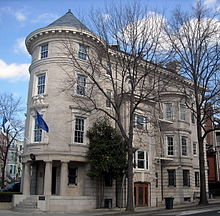
Estonia was a member of the League of Nations from 22 September 1921, has been a member of the United Nations since 17 September 1991, and of NATO since 29 March 2004, as well as the European Union since 1 May 2004. Estonia is also a member of the Organization for Security and Cooperation in Europe (OSCE), Organisation for Economic Co-operation and Development (OECD), Council of the Baltic Sea States (CBSS) and the Nordic Investment Bank (NIB). As an OSCE participating State, Estonia's international commitments are subject to monitoring under the mandate of the U.S. Helsinki Commission. Estonia has also signed the Kyoto protocol.
Since regaining independence, Estonia has pursued a foreign policy of close cooperation with its Western European partners. The two most important policy objectives in this regard have been accession into NATO and the European Union, achieved in March and May 2004 respectively. Estonia's international realignment toward the West has been accompanied by a general deterioration in relations with Russia, most recently demonstrated by the protest triggered by the controversial relocation of the Bronze Soldier World War II memorial in Tallinn.
Since the early 1990s, Estonia is involved in active trilateral Baltic states co-operation with Latvia and Lithuania, and Nordic-Baltic co-operation with the Nordic countries. The Baltic Council is the joint forum of the interparliamentary Baltic Assembly (BA) and the intergovernmental Baltic Council of Ministers (BCM). Nordic-Baltic Eight (NB-8) is the joint co-operation of the governments of Denmark, Estonia, Finland, Iceland, Latvia, Lithuania, Norway and Sweden. Nordic-Baltic Six (NB-6), comprising Nordic-Baltic countries that are European Union member states, is a framework for meetings on EU related issues. Parliamentary co-operation between the Baltic Assembly and Nordic Council began in 1989. Annual summits take place, and in addition meetings are organised on all possible levels: speakers, presidiums, commissions, and individual members. The Nordic Council of Ministers has an office in Tallinn with a subsidiary in Tartu and information points in Narva, Valga and Pärnu. Joint Nordic-Baltic projects include the education programme Nordplus and mobility programmes for business and industry and for public administration.
An important element in Estonia's post-independence reorientation has been closer ties with the Nordic countries, especially Finland and Sweden. Indeed, Estonians consider themselves a Nordic people rather than Balts, based on their historical ties with Sweden, Denmark and particularly Finland. In December 1999, then Estonian foreign minister (and since 2006, president of Estonia) Toomas Hendrik Ilves delivered a speech entitled "Estonia as a Nordic Country" to the Swedish Institute for International Affairs. In 2003, the foreign ministry also hosted an exhibit called "Estonia: Nordic with a Twist".
In 2005, Estonia joined the European Union's Nordic Battle Group. It has also shown continued interest in joining the Nordic Council. Whereas in 1992 Russia accounted for 92% of Estonia's international trade, today there is extensive economic interdependence between Estonia and its Nordic neighbors: three quarters of foreign investment in Estonia originates in the Nordic countries (principally Finland and Sweden), to which Estonia sends 42% of its exports (as compared to 6.5% going to Russia, 8.8% to Latvia, and 4.7% to Lithuania). On the other hand, the Estonian political system, its flat rate of income tax, and its non-welfare-state model distinguish it from the Nordic countries and their Nordic model, and indeed from many other European countries.
The European Union Agency for large-scale IT systems will be based in Tallinn, which is due to start operations at the end of 2012. Estonia will hold the Presidency of the Council of the European Union in the first half of 2018.
Military
The military of Estonia is based upon the Estonian Defence Forces ( Estonian: Kaitsevägi), which is the name of the unified armed forces of the republic with Maavägi (Army), Merevägi (Navy), Õhuvägi (Air Force) and a paramilitary national guard organization Kaitseliit (Defence League). The Estonian National Defence Policy aim is to guarantee the preservation of the independence and sovereignty of the state, the integrity of its land, territorial waters, airspace and its constitutional order. Current strategic goals are to defend the country's interests, develop the armed forces for interoperability with other NATO and EU member forces, and participation in NATO missions.
The current national military service ( Estonian: ajateenistus) is compulsory for men between 18 and 28, and conscripts serve eight-month to eleven-month tours of duty depending on the army branch they serve in. Estonia has retained conscription unlike Latvia and Lithuania and has no plan to transition to a professional army. In 2008, annual military spending reached 1.85% of GDP, or 5 billion kroons, and was expected to continue to increase until 2010, when a 2.0% level was anticipated.
Estonia co-operates with Latvia and Lithuania in several trilateral Baltic defence co-operation initiatives, including Baltic Battalion (BALTBAT), Baltic Naval Squadron (BALTRON), Baltic Air Surveillance Network (BALTNET) and joint military educational institutions such as the Baltic Defence College in Tartu. Future co-operation will include sharing of national infrastructures for training purposes and specialisation of training areas (BALTTRAIN) and collective formation of battalion-sized contingents for use in the NATO rapid-response force. In January 2011 the Baltic states were invited to join NORDEFCO, the defence framework of the Nordic countries.
As of January 2008, the Estonian military had almost 300 troops stationed in foreign countries as part of various international peacekeeping forces, including 35 Defence League troops stationed in Kosovo; 120 Ground Forces soldiers in the NATO-led ISAF force in Afghanistan; 80 soldiers stationed as a part of MNF in Iraq; and 2 Estonian officers in Bosnia-Herzegovina and 2 Estonian military agents in Israeli occupied Golan Heights.
The Estonian Defence Forces have also previously had military missions in Croatia from March until October 1995, in Lebanon from December 1996 until June 1997 and in Macedonia from May until December 2003. Estonia participates in the Nordic Battlegroup and has announced readiness to send soldiers also to Sudan to Darfur if necessary, creating the very first African peacekeeping mission for the armed forces of Estonia.
The Ministry of Defence and the Defence Forces have been working on a cyberwarfare and defence formation for some years now. In 2007, a military doctrine of an e-military of Estonia was officially introduced as the country was under massive cyberattacks in 2007. The proposed aim of the e-military is to secure the vital infrastructure and e-infrastructure of Estonia. The main cyber warfare facility is the Computer Emergency Response Team of Estonia (CERT), founded in 2006. The organization operates on security issues in local networks.
President of the US, George W. Bush announced his support of Estonia as location of a NATO Cooperative Cyber Defence Centre of Excellence (CCDCOE). In the aftermath of the 2007 cyberattacks, plans to combine network defence with Estonian military doctrine have been nicknamed as the Tiger's Defence, in reference to Tiigrihüpe. The CCDCOE started its operations in November 2008.
Economy
As a member of the European Union, Estonia is considered a high-income economy by the World Bank. The country is ranked 16th in the 2012 Index of Economic Freedom, with the freest economy in Eastern Europe and the former Soviet Union. Because of its rapid growth, Estonia has often been described as a Baltic Tiger. Beginning 1 January 2011, Estonia adopted the euro and became the 17th eurozone member state.
According to Eurostat newsrelease published at 21 October 2011, Estonia has the lowest ratio of government debt to GDP among EU countries as 6.7% at the end of 2010. The world media has lately started to describe Estonia as a Nordic country, emphasizing the economic, political and cultural differences between Estonia and its less successful Baltic neighbours.
A balanced budget, almost non-existent public debt, flat-rate income tax, free trade regime, competitive commercial banking sector, innovative e-Services and even mobile-based services are all hallmarks of Estonia's market economy.
Estonia is producing ca 75% of its consumed electricity. In 2011 about 85% of it was generated with locally mined oil shale. Alternative energy sources such as wood, peat, and biomass make up approximately 9% of primary energy production. Renewable wind energy part was ca 6% of total consumption in 2009. Estonia imports needed petroleum products from western Europe and Russia. Oil shale energy, telecommunications, textiles, chemical products, banking, services, food and fishing, timber, shipbuilding, electronics, and transportation are key sectors of the economy. The ice-free port of Muuga, near Tallinn, is a modern facility featuring good transshipment capability, a high-capacity grain elevator, chill/frozen storage, and brand-new oil tanker off-loading capabilities. The railroad serves as a conduit between the West, Russia, and other points to the East.
Estonia today is mainly influenced by developments in Finland, Sweden and Germany, its three largest trade partners. The government recently increased its spending on innovation by a considerable amount. The prime minister of Estonian Reform Party has aimed to raise Estonian GDP per capita to one of the EU's highest by 2022.
Because of the global economic recession that began in 2007, the GDP of Estonia decreased by 1.4% in the 2nd quarter of 2008, over 3% in the 3rd quarter of 2008, and over 9% in the 4th quarter of 2008. The Estonian government made a supplementary negative budget, which was passed by Riigikogu. The revenue of the budget was decreased for 2008 by EEK 6.1 billion and the expenditure by EEK 3.2 billion. In 2010, the economic situation stabilized and started a growth based on strong exports. In the fourth quarter of 2010, Estonian industrial output increased by 23% compared to the year before.
According to Eurostat data, Estonian PPS GDP per capita stood at 67% of the EU average in 2008. In March 2011, the average monthly gross salary in Estonia was 843€
However, there are vast disparities in GDP between different areas of Estonia; currently, over half of the country's GDP is created in Tallinn, the capital and largest city. In 2008, the GDP per capita of Tallinn stood at 172% of the Estonian average, which makes the per capital GDP of Tallinn as high as 115% of the European Union average, exceeding the average levels of other counties.
The unemployment rate is around 11.7%, which is above the EU average, while real GDP growth as of 2011 was 8.0%, five times the euro-zone average. As of 2012, Estonia remains the only euro member with a budget surplus, and with a national debt of only 6%, it is one of the least indebted countries in Europe.
Historic development
By 1929, a stable currency, the kroon, was established. It is issued by the Bank of Estonia, the country's central bank. Trade focused on the local market and the West, particularly Germany and the United Kingdom. Only 3% of all commerce was with the USSR.
Before the Second World War Estonia was mainly an agricultural country whose products such as butter, milk and cheese were widely known on the western European markets. The USSR's annexation of Estonia in 1940 and the ensuing Nazi and Soviet occupation during World War II damaged the Estonian economy. Post-war Sovietization of life continued with the integration of Estonia's economy and industry into the USSR's centrally planned structure.
Since re-establishing independence, Estonia has styled itself as the gateway between East and West and aggressively pursued economic reform and integration with the West. Estonia's market reforms put it among the economic leaders in the former COMECON area. In 1994, based on the economic theories of Milton Friedman, Estonia became one of the first countries to adopt a flat tax, with a uniform rate of 26% regardless of personal income. In January 2005, the personal income tax rate was reduced to 24%. Another reduction to 23% followed in January 2006. The income tax rate was decreased to 21% by January 2008. The Government of Estonia finalised the design of Estonian euro coins in late 2004, and adopted the euro as the country's currency on 1 January 2011, later than planned due to continued high inflation.
In 1999, Estonia experienced its worst year economically since it regained independence in 1991, largely because of the impact of the 1998 Russian financial crisis. Estonia joined the WTO in November 1999. With assistance from the European Union, the World Bank and the Nordic Investment Bank, Estonia completed most of its preparations for European Union membership by the end of 2002 and now has one of the strongest economies of the new member states of the European Union. Estonia joined the OECD in 2010.
Industry and environment
Food, construction, and electronic industries are currently among the most important branches of Estonia's industry. In 2007, the construction industry employed more than 80,000 people, around 12% of the entire country's workforce. Another important industrial sector is the machinery and chemical industry, which is mainly located in Ida-Viru County and around Tallinn.

The oil shale based mining industry, which is also concentrated in East-Estonia, produces around 90% of the entire country's electricity. The extensive oil shale usage however has also caused severe damage to the environment. Although the amount of pollutants emitted to the air have been falling since the 1980s, the air is still polluted with sulfur dioxide from the mining industry that the Soviet Union rapidly developed in the early 1950s. In some areas the coastal seawater is polluted, mainly around the Sillamäe industrial complex.
Estonia is a dependent country in the terms of energy and energy production. In recent years many local and foreign companies have been investing in renewable energy sources. The importance of wind power has been increasing steadily in Estonia and currently the total amount of energy production from wind is nearly 60 MW while at the same time roughly 399 MW worth of projects are currently being developed and more than 2800 MW worth of projects are being proposed in the Lake Peipus area and the coastal areas of Hiiumaa.
Currently, there are plans to renovate some older units of the Narva Power Plants, establish new power stations, and provide higher efficiency in oil shale based energy production. Estonia liberalised 35% of its electricity market in April 2010. The electricity market as whole will be liberalised by 2013.
Together with Lithuania, Poland, and Latvia, the country is considering to participate in the Visaginas nuclear power plant in Lithuania to replace the Ignalina. However, due to the slow pace of the project, Estonia does not rule out building its own nuclear reactor. Another consideration is doing a joint project with Finland because the two electricity grids are connected. The country is considering to apply nuclear power for its oil shale production.
Estonia has a strong information technology sector, partly owing to the Tiigrihüpe project undertaken in mid-1990s, and has been mentioned as the most "wired" and advanced country in Europe in the terms of e-Government of Estonia.
Skype was written by Estonia-based developers Ahti Heinla, Priit Kasesalu, and Jaan Tallinn, who had also originally developed Kazaa.
Trade
| Estonia | Export | Import |
|---|---|---|
| Finland | 18.4% | 18.2% |
| Sweden | 12.4% | 9% |
| Latvia | 8.9% | 5.7% |
| Russia | 8.1% | 13.1% |
| Germany | 5.1% | 12.4% |
| Lithuania | 4.8% | 6.4% |
Estonia has had a market economy since the end of 1990s and one of the highest per capita income levels in Eastern Europe. Proximity to the Scandinavian markets, location between the East and West, competitive cost structure and high-skill labour force have been the major Estonian comparative advantages in the beginning of the 2000s (decade). Tallinn as the largest city has emerged as a financial centre and the Tallinn Stock Exchange joined recently with the OMX system. The current government has pursued tight fiscal policies, resulting in balanced budgets and low public debt.
In 2007, however, a large current account deficit and rising inflation put pressure on Estonia's currency, which was pegged to the Euro, highlighting the need for growth in export-generating industries. Estonia exports mainly machinery and equipment, wood and paper, textiles, food products, furniture, and metals and chemical products. Estonia also exports 1.562 billion kilowatt hours of electricity annually. At the same time Estonia imports machinery and equipment, chemical products, textiles, food products and transportation equipment. Estonia imports 200 million kilowatt hours of electricity annually.
Between 2007 and 2013, Estonia receives 53.3 billion kroons (3.4 billion euros) from various European Union Structural Funds as direct supports by creating the largest foreign investments into Estonia ever. Majority of the European Union financial aid will be invested into to the following fields: energy economies, entrepreneurship, administrative capability, education, information society, environment protection, regional and local development, research and development activities, healthcare and welfare, transportation and labour market.
Demographics
Before World War II, ethnic Estonians constituted 88% of the population, with national minorities constituting the remaining 12%. The largest minority groups in 1934 were Russians, Germans, Swedes, Latvians, Jews, Poles, Finns and Ingrians. The share of Baltic Germans had fallen from 5.3% (~46,700) in 1881 to 1.3% (16,346) in 1934.
Between 1945 and 1989, the share of ethnic Estonians in the population resident within the currently defined boundaries of Estonia dropped to 61%, caused primarily by the Soviet programme promoting mass immigration of urban industrial workers from Russia, Ukraine, and Belarus, as well as by wartime emigration and Joseph Stalin's mass deportations and executions. By 1989, minorities constituted more than one-third of the population, as the number of non-Estonians had grown almost fivefold.
At the end of the 1980s, Estonians perceived their demographic change as a national catastrophe. This was a result of the migration policies essential to the Soviet Nationalisation Programme aiming to russify Estonia – administrative and military immigration of non-Estonians from the USSR coupled with the deportation of Estonians to the USSR. During the purges up to 110,000 Estonians were killed or deported. In the decade following the reconstitution of independence, large-scale emigration by ethnic Russians and the removal of the Russian military bases in 1994 caused the proportion of ethnic Estonians in Estonia to increase from 61% to 69% in 2006.
Modern Estonia is a fairly ethnically heterogeneous country, but this heterogeneity is not a feature of much of the country as the non-Estonian population is concentrated in two of Estonia's counties. Thirteen of Estonia's 15 counties are over 80% ethnic Estonian, the most homogeneous being Hiiumaa, where Estonians account for 98.4%of the population. In the counties of Harju (including the capital city, Tallinn) and Ida-Viru, however, ethnic Estonians make up 60% and 20% of the population, respectively. Russians make up 25.6% of the total population but account for 36% of the population in Harju county and 70% of the population in Ida-Viru county.
The Estonian Cultural Autonomy law that was passed in 1925 was unique in Europe at that time. Cultural autonomies could be granted to minorities numbering more than 3,000 people with longstanding ties to the Republic of Estonia. Before the Soviet occupation, the Germans and Jewish minorities managed to elect a cultural council. The Law on Cultural Autonomy for National Minorities was reinstated in 1993. Historically, large parts of Estonia's northwestern coast and islands have been populated by indigenous ethnically Rannarootslased (Coastal Swedes).
The majority of Estonia's Swedish population of 3,800 fled to Sweden or were deported in 1944. In recent years the numbers of Coastal Swedes has risen again, numbering in 2008 almost 500 people, owing to the property reforms in the beginning of 1990s. In 2005, the Ingrian Finnish minority in Estonia elected a cultural council and was granted cultural autonomy. The Estonian Swedish minority similarly received cultural autonomy in 2007.
Urbanization
Tallinn is the capital and the largest city of Estonia. It lies on the northern coast of Estonia, along the Gulf of Finland. There are 33 cities and several town-parish towns in the country. In total, there are 47 linna, with "linn" in English meaning both "cities" and "towns". More than 70% of the population lives in towns. The 20 largest cities are listed below:
Religion
Estonia's constitution guarantees freedom of religion, separation of church and state, and individual rights to privacy of belief and religion. According to the Dentsu Communication Institute Inc, Estonia is one of the least religious countries in the world, with 75.7% of the population claiming to be irreligious. The Eurobarometer Poll 2005 found that only 16% of Estonians profess a belief in a god, the lowest belief of all countries studied (EU study).
The largest religious denomination in the country is Evangelical Lutheranism, adhered to by 152,000 Estonians (or 14.8% of the population), principally ethnic Estonians. 143,000 inhabitants follow the Eastern Orthodox Christianity, practised chiefly by the Russian minority.
According to the census of 2000, there were about 152,000 Lutherans, 143,000 Orthodox Christians, 5,000 Roman Catholics, 4,268 Jehovah's Witnesses, and 1,000 adherents of Taaraism or Maausk in Estonia (see Maavalla Koda). The Jewish community has an estimated population of about 1,900 (see History of the Jews in Estonia). Around 68,000 people consider themselves atheists.
The country was Christianised by the Teutonic Knights in the 13th century. During the Reformation, Protestantism spread, and the Lutheran church was officially established in Estonia in 1686. Many Estonians profess not to be particularly religious, because religion through the 19th century was associated with German feudal rule. Historically, there has been another minority religion, Russian Old-believers, near Lake Peipus area in Tartu County.
Society
Estonian society has undergone considerable changes over the last twenty years, one of the most notable being the increasing level of stratification, and the distribution of family income. The Gini coefficient has been steadily higher than the European Union average (31 in 2009), although it has clearly dropped. The registered unemployment rate in January 2012 was 7.7%.
Modern Estonia is a multinational country in which 109 languages are spoken, according to a 2000 census. 67.3% of Estonian citizens speak Estonian as their native language, 29.7% Russian, and 3% speak other languages. As of 2 July 2010, 84.1% of Estonian residents are Estonian citizens, 8.6% are citizens of other countries and 7.3% are "citizens with undetermined citizenship". Since 1992 roughly 140,000 people have acquired Estonian citizenship by passing naturalization exams.
The ethnic distribution in Estonia is very homogeneous, where in most counties over 90% of the people are ethnic Estonians. This is in contrast to large urban centers like Tallinn, where Estonians account for 60% of the population, and the remainder is composed mostly of Russian and other Slavic inhabitants, who arrived in Estonia during the Soviet period.
According to surveys, only 5% of the Russian community have considered returning to Russia in the near future. Estonian Russians have developed their own identity – more than half of the respondents recognised that Estonian Russians differ noticeably from the Russians in Russia. When comparing the result with a survey from 2000, then Russians' attitude toward the future is much more positive.
Family
Upon giving birth, the Estonian government grants one of the parents 100% of their former salary for 18 months, plus 320 Euros of one-time support per child. After 18 months, the parent has the right to resume her/his former position. In addition, the parent and child receive free healthcare. Parents who did not work before giving birth (unemployed, students, etc.) receive 278 Euros a month; the top salary is capped at 2,157 Euros a month. These measures, which have been in force from 2005, have not been proven to have had a major positive effect on the birth rate in Estonia, which has increased already since 2001.
Those policy measures concentrate on the first 18 months of the child's life. After 18 months, the monthly state support to a child goes down to 19 Euros a month (for the first two children) and 58 euros (for three or more children), plus free healthcare. There are many exceptions and added bonuses to the rule. For example, the child of a single parent receives twice the sum of child support. The child of an army member receives five times the sum of the child support, and children in foster families receive 20 times the sum of the child support. Despite considerable variation and fluctuations in the support to the family with children, the majority of Estonian families do not face great hardships and the State of The World's Mothers 2011 report ranked Estonia as the 18th best country in the world to be a mother, ahead of countries like Canada and the United States. According to the CIA World Factbook, Estonia has the lowest maternal death rate in the world.
Languages
The official language, Estonian, belongs to the Finnic branch of the Uralic languages. Estonian is closely related to Finnish, spoken on the other side of the Gulf of Finland, and is one of the few languages of Europe that is not of an Indo-European origin. Despite some overlaps in the vocabulary due to borrowings, in terms of its origin, Estonian and Finnish are not related to their nearest geographical neighbours, Swedish, Latvian, and Russian, which are all Indo-European languages.
Russian is still spoken as a secondary language by forty- to seventy-year-old ethnic Estonians, because Russian was the unofficial language of the Estonian SSR from 1944 to 1991 and taught as a compulsory second language during the Soviet era. In 1998, most first- and second-generation industrial immigrants from the former Soviet Union (mainly the Russian SFSR) did not speak Estonian. However, by 2010, 64.1% of non-ethnic Estonians spoke Estonian.
The latter, mostly Russian-speaking ethnic minorities, reside predominantly in the capital city of Tallinn and the industrial urban areas in Ida-Virumaa. In the small Noarootsi Parish in Läänemaa (known as Nuckö kommun in Swedish and Noarootsi vald in Estonian) there are 22 villages with bilingual Swedish and Estonian names.
The most common foreign languages learned by Estonians are English, Russian, Finnish, German, and Swedish.
Education and science
The history of formal education in Estonia dates back to the 13th and 14th centuries when the first monastic and cathedral schools were founded. The first primer in the Estonian language was published in 1575. The oldest university is the University of Tartu, established by the Swedish king Gustav II Adolf in 1632. In 1919, university courses were first taught in Estonian language.
Today's education in Estonia is divided into general, vocational, and hobby. The education system is based on four levels: pre-school, basic, secondary, and higher education. A wide network of schools and supporting educational institutions have been established. The Estonian education system consists of state, municipal, public, and private institutions. There are currently 589 schools in Estonia.
According to the Programme for International Student Assessment, the performance levels of gymnasium-age pupils in Estonia is among the highest in the world: as of 2010, the country was ranked 13th in the quality of its education system, well above the OECD average. Additionally, around 89% of Estonian adults aged 25–64 have earned the equivalent of a high-school degree, one of the highest rates in the industrialized world.
Academic higher education in Estonia is divided into three levels: bachelor's, master's, and doctoral studies. In some specialties (basic medical studies, veterinary, pharmacy, dentistry, architect-engineer, and a classroom teacher programme) the bachelor's and master's levels are integrated into one unit. Estonian public universities have significantly more autonomy than applied higher education institutions.
In addition to organizing the academic life of the university, universities can create new curricula, establish admission terms and conditions, approve the budget, approve the development plan, elect the rector, and make restricted decisions in matters concerning assets. Estonia has a moderate number of public and private universities. The largest public universities are the University of Tartu, Tallinn University of Technology, Tallinn University, Estonian University of Life Sciences, Estonian Academy of Arts; the largest private university is Estonian Business School.
The Estonian Academy of Sciences is the national academy of science. The strongest public non-profit research institute that carries out fundamental and applied research is the National Institute of Chemical Physics and Biophysics (NICPB; Estonian KBFI). The first computer centres were established in late 1950s in Tartu and Tallinn. Estonian specialists contributed in the development of software engineering standards for ministries of the Soviet Union during the 1980s. Estonia spends around 1.44% of its GDP on Research and Development, compared to an EU average of around 2%.
Infrastructure
Transport

Estonia has been an important transit centre since the medieval period. The country's favourable geographical location, along with its developing infrastructure, offers good opportunities for all transport and logistics related activities. Rail transport dominates the cargo sector, carrying 70% of all goods, both domestic and international, while road transport largely dominates passenger transport.
Road transport
The road transport sector dominates passenger transport; almost 90% of all passengers travel by road. The reconstruction of the Tallinn–Tartu motorway has gained national attention as it connects two of the largest cities in the country. The motorway reconstruction (2+2 route) is part of the current Government Coalition programme. Also the proposed permanent connection to Saaremaa Island is in the national infrastructure building programme. The costs of the projects have been estimated in billions of Euros, which have also gained a lot of media attention and caused public debates over the feasibility.
Estonia is the first country in the EU and in the world to introduce a nation-wide, publicly serviced charging system for charging the batteries of electric vehicles. The 165 fast charging stations are equipped with connectors of the CHAdeMO standard. They are located throughout the entire country, including the islands, and have a maximum distance of 40 to 60 km (25 to 37 mi) in between. The charging stations can also be navigated via a smartphone app (currently only for Android). The relatively dense network and 30 minute quick charges are built to enable a country-wide electric vehicle network. The system offers a unitary booking service and several different tariffs, some of which appear attractively low priced. The charging station network puts Estonia at the forefront in Europe even though Norway actually has a higher penetration of electric vehicles. Estonia has a rate of 1 electric vehicle per 1000 capita, whereas Norway has 4 EVs per 1000 capita.
Water transport
Five major cargo ports offer easy navigational access, deep waters, and good ice conditions. The Old City Harbour of Tallinn is the largest passenger port, and one of the biggest and busiest passenger harbours in the Baltic region. It served a record 8.48 million passengers in 2011.
Air transport
There are 12 airports and one heliport in Estonia, of which the Lennart Meri Tallinn Airport is the largest airport, providing services to a number of international carriers flying to 23 destinations.
International rankings
The following are links to international rankings of Estonia.
| Index | Rank | Countries reviewed |
|---|---|---|
| Freedom House Internet Freedom 2012 | 1st | 47 |
| Index of Economic Freedom 2010 | 14th | 157 |
| Privacy International Yearly Privacy ranking of countries, 2007 | 5th | 45 |
| Reporters Without Borders Press Freedom Index 2011–2012 | 3rd | 187 |
| State of World Liberty Index | 1st | 159 |
| Human Development Index 2011 | 34th | 169 |
| Corruption Perceptions Index 2012 | 32nd | 176 |
| Networked Readiness Index 2009–2010 | 25th | 133 |
| Ease of Doing Business Index 2011 | 17th | 158 |
| State of The World's Children's Index 2012 | 10th | 165 |
| State of The World's Women's Index 2012 | 18th | 165 |
| Legatum Prosperity Index 2011 | 33rd | 110 |
According to speedtest.net Estonia has one of the fastest Internet download speeds in the world with an average download speed of 27.12 Mbit/s.


![Location of Estonia (dark green)– in Europe (green & dark grey)– in the European Union (green) — [Legend]](../../images/2761/276190.png)

